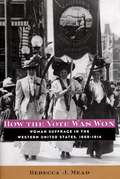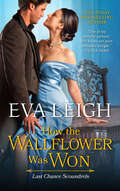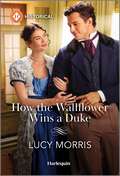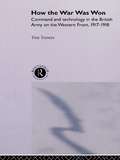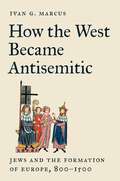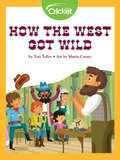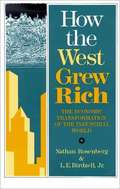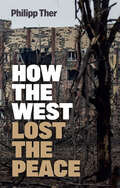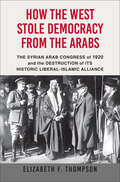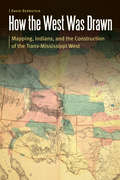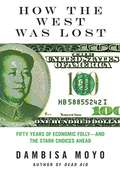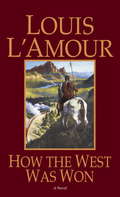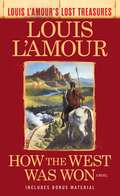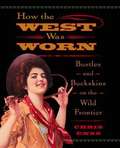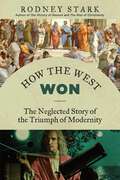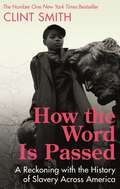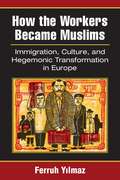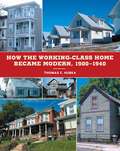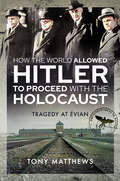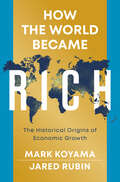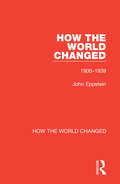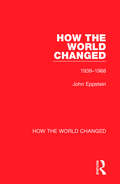- Table View
- List View
How the Vote Was Won: Woman Suffrage in the Western United States, 1868-1914
by Rebecca MeadUncovers how women in the West fought for the right to voteBy the end of 1914, almost every Western state and territory had enfranchised its female citizens in the greatest innovation in participatory democracy since Reconstruction. These Western successes stand in profound contrast to the East, where few women voted until after the ratification of the Nineteenth Amendment in 1920, and the South, where African-American men were systematically disenfranchised. How did the frontier West leap ahead of the rest of the nation in the enfranchisement of the majority of its citizens?In this provocative new study, Rebecca J. Mead shows that Western suffrage came about as the result of the unsettled state of regional politics, the complex nature of Western race relations, broad alliances between suffragists and farmer-labor-progressive reformers, and sophisticated activism by Western women. She highlights suffrage racism and elitism as major problems for the movement, and places special emphasis on the political adaptability of Western suffragists whose improvisational tactics earned them progress.A fascinating story, previously ignored, How the Vote Was Won reintegrates this important region into national suffrage history and helps explain the ultimate success of this radical reform.
How the Wallflower Was Won (Last Chance Scoundrels #2)
by Eva LeighUSA TODAY bestselling author Eva Leigh continues her Last Chance Scoundrels series with a steamy romance between two opposites—a rogue with a taste for wagers and a bookish wallflower—who marry for convenience... but neither bet on falling in love.Finn Ransome is an expert on Lady Luck, which is why he refuses to take a chance on love. Experience has taught him that he’s happier at a gaming table than around people he will, inevitably, disappoint. However, the clock is ticking on his father’s matrimonial demands. But the only woman to catch his eye is a bluestocking who would never consider a rogue like him.After a disastrous first Season, Tabitha Seaton decided to focus on books instead of ballrooms. She hopes to join the Sterling Society, a collective of the most brilliant, influential minds in London. Except, they will never admit an unmarried lady. Now Tabitha needs a husband, and a notorious, handsome gambler may be her best bet.Finn and Tabitha are opposites who have no intention of wagering on a love match, and a calculated marriage of convenience solves all their problems—with no risk to their hearts. Once married, however, their potent attraction boils over into a deep passion that neither expected. When a painful mistake drives the new lovers apart, Finn will risk it all to prove a scoundrel and a wallflower are a winning pair...
How the Wallflower Wins a Duke
by Lucy MorrisBe tantalized by this spicy Regency romanceMarina Fletcher&’s Rules: Rule 1: Spend life composing music in peace. Do not worry about finding a husband. Rule 2: If must worry about finding a husband, marry for love only or commit to becoming a spinster. Rule 3: Resist urge to spend time with the sinfully sexy Duke of Framlingham, who clearly does not believe in love. Rule 4: Never ever say yes to said duke&’s wicked plan for us to silence society&’s expectations with a fake engagement…But what happens when this wallflower breaks every single rule?From Harlequin Historical: Your romantic escape to the past.
How the War Was Won: Command and Technology in the British Army on the Western Front: 1917-1918 (Pen And Sword Military Classics Ser.)
by T.H.E. Travers"How the War Was Won" describes the major role played by the British Expeditionary Force on the Western Front in defeating the German army. In particular, the book explains the methods used in fighting the last year of the war, and raises questions as to whether mechanical warfare could have been more widely used. Using a wide range of unpublished
How the War was Won
by Phillips Payson O'BrienWorld War II is usually seen as a titanic land battle, decided by mass armies, most importantly those on the Eastern Front. Phillips Payson O'Brien shows us the war in a completely different light. In this compelling new history of the Allied path to victory, he argues that in terms of production, technology and economic power, the war was far more a contest of air and sea than land supremacy. He shows how the Allies developed a predominance of air and sea power which put unbearable pressure on Germany and Japan's entire war-fighting machine from Europe and the Mediterranean to the Pacific. Air and sea power dramatically expanded the area of battle and allowed the Allies to destroy over half the Axis' equipment before it had even reached the traditional 'battlefield'. Battles such as El Alamein, Stalingrad and Kursk did not win World War II; air and sea power did.
How the West Became Antisemitic: Jews and the Formation of Europe, 800–1500
by Ivan G. MarcusAn examination of how the Jews—real and imagined—so challenged the Christian majority in medieval Europe that it became a society that was religiously and culturally antisemitic in new ways In medieval Europe, Jews were not passive victims of the Christian community, as is often assumed, but rather were startlingly assertive, forming a Jewish civilization within Latin Christian society. Both Jews and Christians considered themselves to be God&’s chosen people. These dueling claims fueled the rise of both cultures as they became rivals for supremacy. In How the West Became Antisemitic, Ivan Marcus shows how Christian and Jewish competition in medieval Europe laid the foundation for modern antisemitism.Marcus explains that Jews accepted Christians as misguided practitioners of their ancestral customs, but regarded Christianity as idolatry. Christians, on the other hand, looked at Jews themselves—not Judaism—as despised. They directed their hatred at a real and imagined Jew: theoretically subordinate, but sometimes assertive, an implacable &“enemy within.&” In their view, Jews were permanently and physically Jewish—impossible to convert to Christianity. Thus Christians came to hate Jews first for religious reasons, and eventually for racial ones. Even when Jews no longer lived among them, medieval Christians could not forget their former neighbors. Modern antisemitism, based on the imagined Jew as powerful and world dominating, is a transformation of this medieval hatred.A sweeping and well-documented history of the rivalry between Jewish and Christian civilizations during the making of Europe, How the West Became Antisemitic is an ambitious new interpretation of the medieval world and its impact on modernity.
How the West Got Wild
by Tori TelferChummy and Sandra Bee were the rowdiest little kids in Ruby, Arizona. But when they helped start the gold rush in Ruby, people stopped calling them "wild" and "rambunctious" and started calling them "plucky" and "clever."
How the West Grew Rich: The Economic Transformation of the Industrial World
by Nathan Rosenberg L. E. BirdzellHow did the West—Europe, Canada, and the United States—escape from immemorial poverty into sustained economic growth and material well-being when other societies remained trapped in an endless cycle of birth, hunger, hardship, and death? In this elegant synthesis of economic history, two scholars argue that it is the political pluralism and the flexibility of the West's institutions—not corporate organization and mass production technology—that explain its unparalleled wealth.
How the West Lost the Peace: The Great Transformation Since the Cold War
by Philipp TherWhen the Berlin Wall was stormed and the Soviet Union fell apart, the West and above all the United States looked like the sole victors of history. Three decades later, the spirit of triumph rings hollow. What went wrong? In this sequel to his award-winning history of neoliberal Europe, the renowned historian Philipp Ther searches for an answer to this question. He argues that global capitalism created many losers, preparing the ground for the rise of right-wing populists and nationalists. He shows how the promise of prosperity and freedom did not catch on sufficiently in Eastern Europe despite material progress, and how the West lost Russia and alienated Turkey. Neoliberal capitalism also left the world poorly prepared to cope with Covid-19, and the pandemic further weakened the Western hegemony of the post-1989 period, which is now brutally contested by Russia’s war against Ukraine. The double punch of the pandemic and the biggest war in Europe since 1945 has brought to a close the age of transformation that was inaugurated by the end of the Cold War. This penetrating analysis of the disarray of the post-1989 world will be of great interest to anyone who wishes to understand how we got to where we are today and the tremendous challenges we now face.
How the West Stole Democracy from the Arabs: The Syrian Arab Congress of 1920 and the Destruction of Its Historical Liberal-Islamic Alliance
by Elizabeth F. Thompson“This expertly researched account brings to life a meaningful but underexplored chapter in world history.” —Publishers WeeklyWhen Europe’s Great War engulfed the Ottoman Empire, Arab nationalists rose in revolt against the Turks. The British supported the Arabs’ fight for an independent state and sent an intelligence officer, T.E. Lawrence, to join Prince Faisal, leader of the Arab army and a descendant of the Prophet. In October 1918, Faisal, Lawrence, and the Arabs victoriously entered Damascus, where they declared a constitutional government in an independent Greater Syria.At the Paris Peace Conference, Faisal won the support of Woodrow Wilson, who sent an American commission to Syria to survey the political aspirations of its people. However, other Entente leaders at Paris—and later San Remo—schemed against the Arab democracy, which they saw as a threat to their colonial rule. On March 8, 1920, the Syrian-Arab Congress declared independence and crowned Faisal king of a “representative monarchy.” Rashid Rida, a leading Islamic thinker of the day, led the constituent assembly to establish equality for all citizens, including non-Muslims, under a full bill of rights.But France and Britain refused to recognize the Damascus government, instead imposing a system of mandates on the Arab provinces of the defeated Ottoman Empire, on the pretext that Arabs weren’t yet ready for self-government. Under such a mandate, the French invaded Syria in April, crushing the Arab government and sending Faisal and Congress leaders into exile. The fragile coalition of secular modernizers and Islamic reformers that might have established democracy in the Arab world was destroyed, with profound consequences that reverberate still.Using many previously untapped primary sources, including contemporary newspaper accounts and letters, minutes from the Syrian-Arab Congress, and diary and journal entries from participants, How The West Stole Democracy From The Arabs is a groundbreaking account of this extraordinary, brief moment of unity and hope—and of its destruction.“Important and fascinating.” —Amaney A. Jamal, Edwards S. Sanford Professor of Politics, Princeton University
How the West Was Drawn: Mapping, Indians, and the Construction of the Trans-Mississippi West (Borderlands and Transcultural Studies)
by David BernsteinHow the West Was Drawn explores the geographic and historical experiences of the Pawnees, the Iowas, and the Lakotas during the European and American contest for imperial control of the Great Plains during the eighteenth and nineteenth centuries. David Bernstein argues that the American West was a collaborative construction between Native peoples and Euro-American empires that developed cartographic processes and culturally specific maps, which in turn reflected encounter and conflict between settler states and indigenous peoples. Bernstein explores the cartographic creation of the Trans-Mississippi West through an interdisciplinary methodology in geography and history. He shows how the Pawnees and the Iowas—wedged between powerful Osages, Sioux, the horse- and captive-rich Comanche Empire, French fur traders, Spanish merchants, and American Indian agents and explorers—devised strategies of survivance and diplomacy to retain autonomy during this era. The Pawnees and the Iowas developed a strategy of cartographic resistance to predations by both Euro-American imperial powers and strong indigenous empires, navigating the volatile and rapidly changing world of the Great Plains by brokering their spatial and territorial knowledge either to stronger indigenous nations or to much weaker and conquerable American and European powers.How the West Was Drawn is a revisionist and interdisciplinary understanding of the global imperial contest for North America’s Great Plains that illuminates in fine detail the strategies of survival of the Pawnees, the Iowas, and the Lakotas amid accommodation to predatory Euro-American and Native empires.
How the West Was Lost: Fifty Years of Economic Folly---And the Stark Choices Ahead
by Dambisa MoyoDambisa Moyo offers a bold account of the decline of the economic supremacy of the West. She examines how the West's flawed financial decisions and blinkered political and military choices have resulted in an economic and geopolitical seesaw that is now poised to tip in favor of the emerging world.
How the West Was Won
by Louis L'AmourThey came by river and by wagon train, braving the endless distances of the Great Plains and the icy passes of the Sierra Nevada. They were men like Linus Rawlings, a restless survivor of Indian country who'd headed east to see the ocean but left his heart--and his home--in the West. They were women like Lilith Prescott, a smart, spirited beauty who fled her family and fell for a gambling man in the midst of a frontier gold boom. These pioneering men and women sowed the seeds of a nation with their courage--and with their blood. Here is the story of how their paths would meet amid the epic struggle against fierce enemies and nature's cruelty, to win for all time the rich and untamed West.From the Paperback edition.
How the West Was Won: A Novel (Louis L'Amour's Lost Treasures)
by Louis L'AmourAs part of the Louis L’Amour’s Lost Treasures series, this edition contains exclusive bonus materials!They came by river and by wagon train, braving the endless distances of the Great Plains and the icy passes of the Sierra Nevada. They were men like Linus Rawlings, a restless survivor of Indian country who’d headed east to see the ocean but left his heart—and his home—in the West. They were women like Lilith Prescott, a smart, spirited beauty who fled her family and fell for a gambling man in the midst of a frontier gold boom. These pioneering men and women sowed the seeds of a nation with their courage—and with their blood. Here is the story of how their paths would meet amid the epic struggle against fierce enemies and nature’s cruelty, to win for all time the rich and untamed West.Louis L’Amour’s Lost Treasures is a project created to release some of the author’s more unconventional manuscripts from the family archives. In Louis L’Amour’s Lost Treasures: Volumes 1, Beau L’Amour takes the reader on a guided tour through many of the finished and unfinished short stories, novels, and treatments that his father was never able to publish during his lifetime. L’Amour’s never-before-seen first novel, No Traveller Returns, will also be released as a Lost Treasures publication, followed by Louis L’Amour’s Lost Treasures: Volume 2. Additionally, many beloved classics such as Last of the Breed and Bendigo Shafter will be rereleased with an exclusive Lost Treasures postscript featuring previously unpublished material, including outlines, plot notes, and alternate drafts. These postscripts tell the story behind the stories that millions of readers have come to know and cherish.
How the West Was Worn: Bustles and Buckskins on the Wild Frontier
by Chris EnssFashion that was in vogue in the East was highly desirable to pioneers during the frontier period of the American West. It was also extraordinarily difficult to obtain, often impractical, and sometimes the clothing was just not durable enough for the men and women who were forging new homes for themselves in the West. Full hoopskirts were of little use in a soddy on the prairie,and chaps and spurs were a vital part of the cowboy's equipment. In this book, author Chris Enss examines the fashion that shaped the frontier. Short essays; brief clips from letters, magazines, and other period sources; and period illustrations demonstrate the sometimes bizarre, often beautiful, and frequently highly inventive ways of dressing oneself in the Old West.
How the West Won: The Neglected Story of the Triumph of Modernity
by Rodney StarkFinally the Truth about the Rise of the WestModernity developed only in the West--in Europe and North America. Nowhere else did science and democracy arise; nowhere else was slavery outlawed. Only Westerners invented chimneys, musical scores, telescopes, eyeglasses, pianos, electric lights, aspirin, and soap. The question is, Why? Unfortunately, that question has become so politically incorrect that most scholars avoid it. But acclaimed author Rodney Stark provides the answers in this sweeping new look at Western civilization. How the West Won demonstrates the primacy of uniquely Western ideas--among them the belief in free will, the commitment to the pursuit of knowledge, the notion that the universe functions according to rational rules that can be discovered, and the emphasis on human freedom and secure property rights. Taking readers on a thrilling journey from ancient Greece to the present, Stark challenges much of the received wisdom about Western history. How the West Won shows, for example:· Why the fall of Rome was the single most beneficial event in the rise of Western civilization· Why the "Dark Ages" never happened· Why the Crusades had nothing to do with grabbing loot or attacking the Muslim world unprovoked· Why there was no "Scientific Revolution"· Why scholars' recent efforts to dismiss the importance of battles are ridiculous: had the Greeks lost at the Battle of Marathon, we probably would never have heard of Plato or Aristotle Stark also debunks absurd fabrications that have flourished in the past few decades: that the Greeks stole their culture from Africa; that the West's "discoveries" were copied from the Chinese and Muslims; that Europe became rich by plundering the non-Western world. At the same time, he reveals the woeful inadequacy of recent attempts to attribute the rise of the West to purely material causes--favorable climates, abundant natural resources, guns and steel. How the West Won displays Rodney Stark's gifts for lively narrative history and making the latest scholarship accessible to all readers. This bold, insightful book will force you to rethink your understanding of the West and the birth of modernity--and to recognize that Western civilization really has set itself apart from other cultures.
How the West Won: The Neglected Story of the Triumph of Modernity
by Rodney StarkFinally the Truth about the Rise of the West Modernity developed only in the West—in Europe and North America. Nowhere else did science and democracy arise; nowhere else was slavery outlawed. Only Westerners invented chimneys, musical scores, telescopes, eyeglasses, pianos, electric lights, aspirin, and soap. The question is, Why? Unfortunately, that question has become so politically incorrect that most scholars avoid it. But acclaimed author Rodney Stark provides the answers in this sweeping new look at Western civilization. How the West Won demonstrates the primacy of uniquely Western ideas—among them the belief in free will, the commitment to the pursuit of knowledge, the notion that the universe functions according to rational rules that can be discovered, and the emphasis on human freedom and secure property rights. Taking readers on a thrilling journey from ancient Greece to the present, Stark challenges much of the received wisdom about Western history. Stark also debunks absurd fabrications that have flourished in the past few decades: that the Greeks stole their culture from Africa; that the West&’s &“discoveries&” were copied from the Chinese and Muslims; that Europe became rich by plundering the non-Western world. At the same time, he reveals the woeful inadequacy of recent attempts to attribute the rise of the West to purely material causes—favorable climates, abundant natural resources, guns and steel. How the West Won displays Rodney Stark&’s gifts for lively narrative history and making the latest scholarship accessible to all readers. This bold, insightful book will force you to rethink your understanding of the West and the birth of modernity—and to recognize that Western civilization really has set itself apart from other cultures.
How the Word Is Passed: A Reckoning with the History of Slavery Across America
by Clint SmithBeginning in his hometown of New Orleans, Clint Smith leads the reader on an unforgettable tour of monuments and landmarks - those that are honest about the past and those that are not - that offer an intergenerational story of how slavery has been central in shaping America's collective history.It is the story of the Monticello Plantation in Virginia, the estate where Thomas Jefferson wrote letters espousing the urgent need for liberty while enslaving more than four hundred people. It is the story of the Whitney Plantation, one of the only former plantations devoted to preserving the experience of the enslaved people whose lives and work sustained it. It is the story of Angola, a former plantation-turned-maximum-security prison in Louisiana that is filled with Black men who work across the 18,000-acre land for virtually no pay. And it is the story of Blandford Cemetery, the final resting place of tens of thousands of Confederate soldiers.A deeply researched and transporting exploration of the legacy of slavery and its imprint on centuries of American history, How the Word Is Passed illustrates how some of America's most essential stories are hidden in plain view - whether in places we might drive by on our way to work, holidays such as Juneteenth or entire neighbourhoods like downtown Manhattan, where the brutal history of the trade in enslaved men, women and children has been deeply imprinted.Informed by scholarship and brought to life by the story of people living today, Smith's debut work of non-fiction is a landmark of reflection and insight that offers a new understanding of the hopeful role that memory and history can play in making sense of the United States and how it has come to be.
How the Word Is Passed: A Reckoning with the History of Slavery Across America
by Clint SmithInstant #1 New York Times bestseller. "The Atlantic writer drafts a history of slavery in this country unlike anything you’ve read before” (Entertainment Weekly). <P><P>Beginning in his hometown of New Orleans, Clint Smith leads the reader on an unforgettable tour of monuments and landmarks—those that are honest about the past and those that are not—that offer an intergenerational story of how slavery has been central in shaping our nation’s collective history, and ourselves. <P><P>It is the story of the Monticello Plantation in Virginia, the estate where Thomas Jefferson wrote letters espousing the urgent need for liberty while enslaving more than four hundred people. It is the story of the Whitney Plantation, one of the only former plantations devoted to preserving the experience of the enslaved people whose lives and work sustained it. It is the story of Angola, a former plantation–turned–maximum-security prison in Louisiana that is filled with Black men who work across the 18,000-acre land for virtually no pay. And it is the story of Blandford Cemetery, the final resting place of tens of thousands of Confederate soldiers. <P><P>A deeply researched and transporting exploration of the legacy of slavery and its imprint on centuries of American history, How the Word Is Passed illustrates how some of our country’s most essential stories are hidden in plain view—whether in places we might drive by on our way to work, holidays such as Juneteenth, or entire neighborhoods like downtown Manhattan, where the brutal history of the trade in enslaved men, women, and children has been deeply imprinted. <P><P>Informed by scholarship and brought to life by the story of people living today, Smith’s debut work of nonfiction is a landmark of reflection and insight that offers a new understanding of the hopeful role that memory and history can play in making sense of our country and how it has come to be. <P><P><b>A New York Times Best Seller</b>
How the Workers Became Muslims: Immigration, Culture, and Hegemonic Transformation in Europe
by Ferruh YilmazWriting in the beginning of the 1980s, Ernesto Laclau and Chantal Mouffe explored possibilities for a new socialist strategy to capitalize on the period's fragmented political and social conditions. Two and a half decades later, Ferruh Yilmaz acknowledges that the populist Far Right-not the socialist movement-has demonstrated greater facility in adopting successful hegemonic strategies along new structural lines Laclau and Mouffe imagined. Right-wing hegemonic strategy, Yilmaz argues, has led to the reconfiguration of internal fault lines in European societies. Yilmaz's primary case study is Danish immigration discourse, but his argument contextualizes his study in terms of questions of current concern across Europe, where right-wing groups that were long on the fringes of "legitimate" politics have managed to make significant gains with populations traditionally aligned with the Left. Specifically, Yilmaz argues that sociopolitical space has been transformed in the last three decades such that group classification has been destabilized to emphasize cultural rather than economic attributes. According to this point-of-view, traditional European social and political splits are jettisoned for new "cultural" alliances pulling the political spectrum to the right, against the "corrosive" presence of Muslim immigrants, whose own social and political variety is flattened into an illusion of alien sameness. Book jacket.
How the Working-Class Home Became Modern, 1900–1940 (Architecture, Landscape and Amer Culture)
by Thomas C. HubkaThe transformation of average Americans&’ domestic lives, revealed through the mechanical innovations and physical improvements of their homes At the turn of the nineteenth century, the average American family still lived by kerosene light, ate in the kitchen, and used an outhouse. By 1940, electric lights, dining rooms, and bathrooms were the norm as the traditional working-class home was fast becoming modern—a fact largely missing from the story of domestic innovation and improvement in twentieth-century America, where such benefits seem to count primarily among the upper classes and the post–World War II denizens of suburbia. Examining the physical evidence of America&’s working-class houses, Thomas C. Hubka revises our understanding of how widespread domestic improvement transformed the lives of Americans in the modern era. His work, focused on the broad central portion of the housing population, recalibrates longstanding ideas about the nature and development of the &“middle class&” and its new measure of improvement, &“standards of living.&”In How the Working-Class Home Became Modern, 1900–1940, Hubka analyzes a period when millions of average Americans saw accelerated improvement in their housing and domestic conditions. These improvements were intertwined with the acquisition of entirely new mechanical conveniences, new types of rooms and patterns of domestic life, and such innovations—from public utilities and kitchen appliances to remodeled and multi-unit housing—are at the center of the story Hubka tells. It is a narrative, amply illustrated and finely detailed, that traces changes in household hygiene, sociability, and privacy practices that launched large portions of the working classes into the middle class—and that, in Hubka&’s telling, reconfigures and enriches the standard account of the domestic transformation of the American home.
How the World Allowed Hitler to Proceed with the Holocaust: Tragedy at Evian
by Tony MatthewsIn July 1938 the United States, Great Britain and thirty other countries participated in a vital conference at Évian-les-Bains, France, to discuss the persecution and possible emigration of the European Jews, specifically those caught under the anvil of Nazi atrocities. However, most of those nations rejected the pleas then being made by the Jewish communities, thus condemning them to the Holocaust. There is no doubt that the Évian conference was a critical turning point in world history. The disastrous outcome of the conference set the stage for the murder of six million people. Today we live in a world defined by turmoil with a disturbing rise of authoritarian governments and ultra right-wing nationalism. The plight of refugees is once more powerfully affecting public attitudes towards those most in need. Now, on the 76th anniversary of the liberation of Auschwitz and the end of the Second World War, it’s time to reflect on the past to ensure we never again make the same mistakes. This book also shines a spotlight on some of the astonishing and courageous stories of heroic efforts of individuals and private organizations who, despite the decisions made at Évian, worked under extremely dangerous conditions, frequently giving their own lives to assist in the rescue of the Jewish people.
How the World Became Rich: The Historical Origins of Economic Growth
by Jared Rubin Mark KoyamaMost humans are significantly richer than their ancestors. Humanity gained nearly all of its wealth in the last two centuries. How did this come to pass? How did the world become rich?Mark Koyama and Jared Rubin dive into the many theories of why modern economic growth happened when and where it did. They discuss recently advanced theories rooted in geography, politics, culture, demography, and colonialism. Pieces of each of these theories help explain key events on the path to modern riches. Why did the Industrial Revolution begin in 18th-century Britain? Why did some European countries, the US, and Japan catch up in the 19th century? Why did it take until the late 20th and 21st centuries for other countries? Why have some still not caught up?Koyama and Rubin show that the past can provide a guide for how countries can escape poverty. There are certain prerequisites that all successful economies seem to have. But there is also no panacea. A society’s past and its institutions and culture play a key role in shaping how it may – or may not – develop.
How the World Changed: Volume 1 1900-1939 (How the World Changed)
by John EppsteinFirst published in 1969, How the World Changed: Volume 1 1900-1939 is the first of two volumes that together outline the political history of the twentieth century up to 1968. This volume extends from 1900-1939 and explores life prior to, during, and after the First World War. In doing so, it covers significant political events and features of the period, including the Chinese Revolution and the rise of Japan, the different stages of the First World War, the peace process, the Russian Revolution, economic challenges, and the British Empire and Commonwealth.
How the World Changed: Volume 2 1939-1968 (How the World Changed)
by John EppsteinFirst published in 1969, How the World Changed: Volume 2 1939-1968 is the second of two volumes that together outline the political history of the twentieth century up to 1968. This volume covers the period from 1939-1968 and examines the history and politics of the Second World War and the state of the world in the years that followed it, including economic recovery, Soviet expansion, the Chinese People’s Republic, and shifts in world power.
